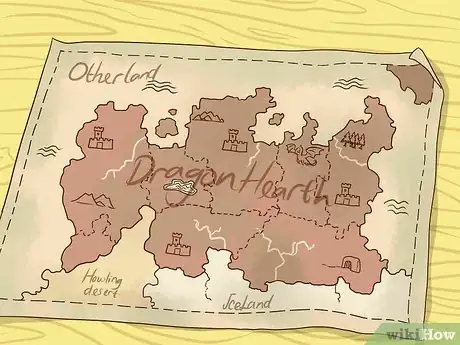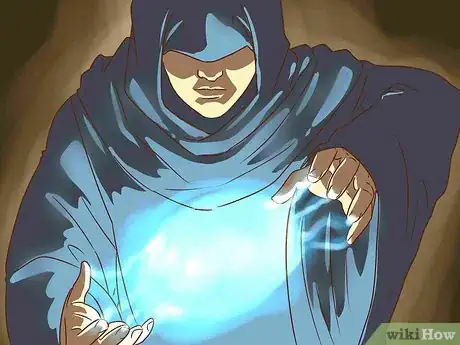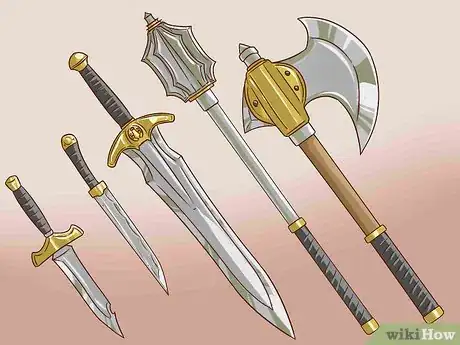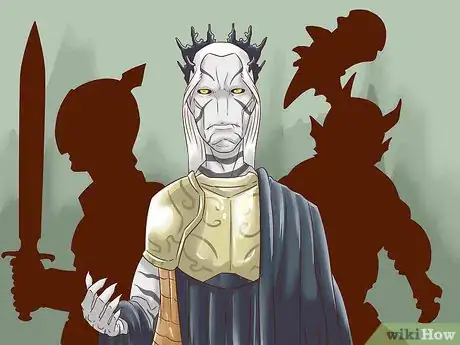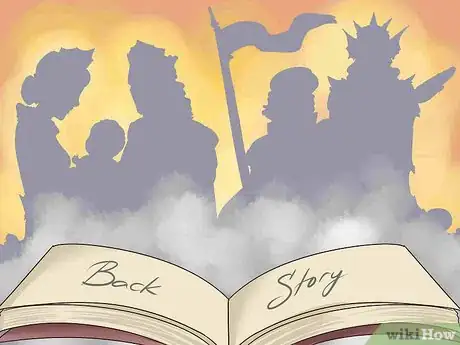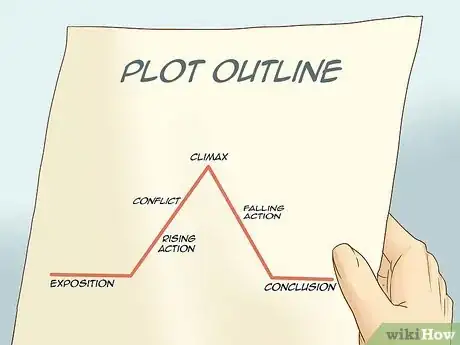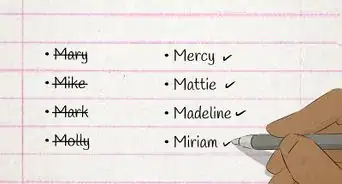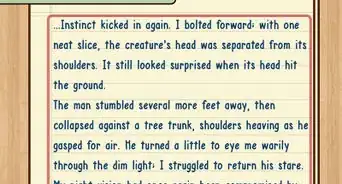This article was co-authored by Stephanie Wong Ken, MFA. Stephanie Wong Ken is a writer based in Canada. Stephanie's writing has appeared in Joyland, Catapult, Pithead Chapel, Cosmonaut's Avenue, and other publications. She holds an MFA in Fiction and Creative Writing from Portland State University.
There are 7 references cited in this article, which can be found at the bottom of the page.
wikiHow marks an article as reader-approved once it receives enough positive feedback. In this case, 88% of readers who voted found the article helpful, earning it our reader-approved status.
This article has been viewed 105,712 times.
Medieval fantasy is one of the most popular genres of fantasy writing. Whether you are creating a world of sword fighting and land conquering or a world of otherworldly beings plotting against one another, a medieval setting can help add to the drama of your story. To write a medieval fantasy novel, you should work on building your medieval setting and create unique characters so you are prepared when you sit down and write your novel.
Steps
Building the Medieval Setting
-
1Borrow and tweak settings from medieval history. Many medieval fantasy novels, from George R.R. Martin’s A Song of Ice and Fire to J.R.R. Tolkien’s The Lord of the Rings, draw on real historical events and settings. You may use a known medieval battle, such as The War of the Roses, or a location in medieval times to act as the stage or setting for your novel. You may need to research medieval historical events and locations to get some inspiration for your story’s setting.[1]
- Keep in mind many medieval fantasy novels use medieval Europe as a backdrop, but this can start to feel cliche if it is done too often. You may want to consider a medieval setting beyond Europe, doing research into other events and locations in medieval history that may work as a template for your novel.
- You should try to mix and match different historical events and occurrences in medieval times so your novel does not seem too attached to real life history. You are writing fiction after all, so you can steal, borrow, and tweak from real life settings and events as you see fit.
-
2Describe the landscape and terrain. You should consider how the landscape appears to your characters and how your characters interact with the terrain. Is your landscape populated by medieval castles and moats? Does your terrain have a variety of medieval elements, such as markets and brothels? How does nature function in the landscape?[2]
- The landscape of your novel may also have different areas, such as different cities, towns, and villages. There may be one landscape that is populated by castles and one landscape that is populated with huts or tents.
- You should also consider how the terrain affects the weather of a certain area. Perhaps it is very cold and winter all the time in certain areas of the setting and warm and desert-like in other areas.
Advertisement -
3Create a map of your setting. It may also be helpful to have a visual representation of your setting so you have a better sense of what it looks like. You may sit down and sketch out a bare bones map of the different sections or areas in your setting, as well as the names of these areas. Use colored pencils or marker to draw different geographical details in your setting, from mountains to rivers to castles to fortresses to villages.
- When you are creating names for different areas in your setting, you should try to come up with unique names that are not obvious or one note. Rather than call an area that is cold and wintery “Ice World”, for example, maybe you come up with a more unique name based on the history of the area, such as “Queen’s Ice Pass” or “The Frigid Land”. This will make the name seem more believable and creative.[3]
-
4Decide how magic works in your setting. A medieval fantasy novel will almost definitely contain at least some elements of magic. Your setting may be infused with magical elements, such as locations that shape shift or areas that are protected by a magical dome. Or your setting may only have a small amount of magical elements, such as a magical waterfall or a magical stone, hidden away in a cave. You should consider how magic functions in your setting so you are aware of how it will affect your characters and your storyline. You may also want to decide where it falls on the scale of the hardness of language. Hard means it has many rules, and you can easily define these rules (e.g. Inheritance), and soft means it has abstract, incompilable rules (e.g. Lord of the Rings). [4]
- You may also want to determine if you are going to tie in magic to how it was represented in medieval times. Perhaps your setting only contains magic that was available or known in medieval times, or perhaps the magic in your setting is a variation on the magic of medieval times.
- For example, witches were actually considered skilled in medicine and healing in medieval times, though they were often feared and demonized. You may then have variations on witchcraft in the setting of your novel.[5]
-
5Determine the medieval weapons used in your setting. To make your setting feel more believable, you may include medieval weaponry. In medieval times, medieval warfare was often bloody and ugly, with fighters using big pieces of steel to hack at each other. If your setting is going to explore medieval times from a fantasy perspective, you may need to depict the weapons and battles based on what was available at the time. Some common medieval weapons include:[6] [7]
- Daggers: These were the first useful metal weapons in medieval times and were often used for thrusting or slashing.
- Dirks: These are long daggers that were made by cutting down the blade of a sword and were used for thrusting or slashing.
- Swords: These were the most common weapons in medieval times, often made of steel and sharpened on both sides. Another variation was the two-handed sword, which was a larger sword that was very heavy and required two hands to wield it effectively in a battle.
- Maces: These were weapons made with wooden handles and steel or iron balls at the end. The ball may have had spikes on it. Often, these were used to penetrate hard armor.
- Axes: These weapons were made of metal and wood, and came in many variations. Often they were used for thrusting and cutting an opponent.
Creating the Novel’s Characters
-
1Lean on real life figures in medieval history. You should get inspiration for your characters by looking at real figures that existed in medieval times. This may be wealthy landowners or family houses, as well as typical roles that existed in medieval villages, such as the town blacksmith or the town priest. Using real life figures can help you create believable characters for your novel.[8] [9]
- For example, George R.R. Martin used the medieval families of the Yorks and the Lancasters in The War of the Roses as inspiration for his own family houses in A Song of Ice and Fire. You can also take medieval historical figures and tweak them so they are fictional representations.
-
2Create “grey” characters. As you create your characters, you should try to steer clear of cliche characters and familiar tropes in fantasy writing. Rather than have a “dark lord” character who is the source of all evil, you should strive to create “grey” characters instead. These are characters who are not purely evil or purely good, and contain flaws like any other human being. Characters who are flawed and conflicted are often more interesting and engaging than characters who are perfect.[10]
- As you create your characters, think about how they can be both heroic and selfish in different moments or situations. You may have a main character who is motivated by a good cause or purpose but who must also do awful or morally questionable things to achieve her goal. Or, you may have an antagonist who is selfish and considered evil, but still has the capacity to love his children or experience loneliness and sadness.
-
3Make sure your characters are diverse and unique. Another common fantasy cliche to avoid is the “one race” idea, where there is no diversity or variation in your characters. This often leads to stale, predictable characters who do not seem relatable or realistic. Instead, you should try to focus on having a variety of character types, backgrounds, genders, and sexual preferences represented in your novel.[11] [12]
- Avoid creating a non-human race that is all the same, dressing in the same clothing and acting in very similar ways, or a race of humans who all speak with the same voice or have the same mannerisms. Instead, think about how you can distinguish different characters within the same race, group, or tribe. This could be by having different genders wear different clothing or by having each person in a group act in different ways. Maybe different races have different languages and unique ways of communicating.
- Another way you can do this is to have the different groups bounce off each other. For example, maybe the non-human race puts a greater value on sustainability and preserving the Earth’s resources. This is counter to how the human race views nature, as something to exploit or use up.
-
4Give each character a backstory and a perspective. You can also make sure your characters feel nuanced and distinct by giving each character a personal history. A character’s backstory, such as how they arrived at where they are now in your story, their family history, and their childhood experiences, can all help to create a more unique character.[13] [14]
- You can also do this by trying to inhabit the perspective of each character in your novel. Rather than write from the third person perspective, where you hover over all your characters like God, try writing in the first person perspective of each of your characters. This will allow you to explore that character’s point of view and give the reader access to their internal thoughts and feelings.
Writing the Novel
-
1Create a plot outline. You can do this by using a plot diagram or by using the snowflake method. Creating a plot outline can help you get a big picture sense of your novel and make it easier to sit down and write.
- Your plot outline may not map out the novel completely or contain all the moving parts of the novel. But it should at least notate the rising action, climax, and falling action of the novel. This way, you are aware of what you are writing toward and what your character’s goals are.
-
2Craft a strong opening line. Draw your reader in right away by working on an engaging first line that create suspense and curiosity. Try to keep the opening line clear and easy to understand, but do not give everything away at first. You want to keep your reader hooked, but still guessing as she turns the page.[15]
- For example, you may refer to the opening line in Stephen King’s The Gunslinger: “The man in black fled across the desert and the gunslinger followed.” This opening line is great because it presents a startling image, a man dressed in black in a hot desert, and it introduces the main character of the novel, the gunslinger, in pursuit. The line has action, character, and setting all in one.
-
3Avoid cliche descriptions and details. You should also work on a language level to resist cliche, which are phrases that are used so often in common speech that they lose their meaning. If you start to write something and feel as though you have heard it before, it is likely a cliche. You should instead strive to create unique descriptions and unusual details in your medieval fantasy novel.[16]
- For example, rather than describe a fantastical beast as “different than others” or “a sight to behold”, you may focus on specific details about the beast. You may write, “The beast had thick, brown hair on his arms and legs, with eyes on the palms of his hands and antennas on his head.” This is detailed and paints a startling picture in the reader’s mind.
-
4Make sure your characters are in conflict with one another. To move your novel along, you need conflict and tension. This can come from external forces acting on your characters, such as a raging war or an incoming natural disaster. But there should also be internal forces at work, such as conflict between your characters or conflict within your characters. Maintaining a constant stream of conflict in the novel will propel the story forward and keep your reader engaged.[17]
- For example, maybe in your medieval fantasy novel there are medieval families who are at war with each other. You may then have two characters who are on opposite sides of the war with the same goal or purpose. Try to place these two characters in a scene together and have them battle, with words or with swords. Then, continue to try to have these two characters interact in various ways throughout the novel. This will ensure there is always conflict brewing in your story.
-
5Write a first draft and then revise. Sit down with your map of your setting and your plot outline. Focus on creating a first draft of your novel, writing nuanced descriptions and describing unique, diverse characters. Make sure you ground your reader in your medieval fantasy world so she can get a clear sense of how it feels to inhabit your setting. You should then revise your first draft as many times as it takes for it to feel good enough to share with the world.
- You may create a writing plan, where you write a certain number of words a day or hit a certain page count by the end of the week. This can be useful if you tend to procrastinate and have a hard time staying motivated when you sit down to write.
- You should also read your writing out loud as you revise so you can determine how your writing flows on the page. You may share your first drafts with others to get feedback and perspective on your work. Be willing to take feedback and constructive criticism, as this will only make your medieval fantasy novel that much better.
Community Q&A
-
QuestionDo publishers reject books written by children?
 DonaganTop AnswererPublishers like a manuscript that is interesting, informative, entertaining and intelligently written. They don't care how old the author is.
DonaganTop AnswererPublishers like a manuscript that is interesting, informative, entertaining and intelligently written. They don't care how old the author is. -
QuestionWhat if I want to publish the book?
 Community AnswerYou can either self-publish or send your work to a publisher. If you send it to a publisher, you may be rejected.
Community AnswerYou can either self-publish or send your work to a publisher. If you send it to a publisher, you may be rejected. -
QuestionDoes my book need to have a sequel to it? I read many fantasy novels with sequels, and I barely see any books without one.
 Community AnswerNo, your book doesn't need a sequel. It's true many other fantasy novels have sequels, but its not required in order to be a successful story.
Community AnswerNo, your book doesn't need a sequel. It's true many other fantasy novels have sequels, but its not required in order to be a successful story.
References
- ↑ http://www.lifehacker.com.au/2013/11/ten-tips-on-writing-a-fantasy-saga-from-game-of-thrones-author-george-r-r-martin/
- ↑ http://www.thecreativepenn.com/2013/06/27/writing-fantasy/
- ↑ http://gizmodo.com/7-worldbuilding-tropes-science-fiction-and-fantasy-need-1659804610
- ↑ http://www.thecreativepenn.com/2013/06/27/writing-fantasy/
- ↑ http://www.historyextra.com/feature/brief-history-medieval-magic
- ↑ http://www.stormthecastle.com/mainpages/for_writers/medieval-weapons-for-fantasy-writers.htm
- ↑ http://www.lifehacker.com.au/2013/11/ten-tips-on-writing-a-fantasy-saga-from-game-of-thrones-author-george-r-r-martin/
- ↑ http://www.lifehacker.com.au/2013/11/ten-tips-on-writing-a-fantasy-saga-from-game-of-thrones-author-george-r-r-martin/
- ↑ http://gizmodo.com/7-worldbuilding-tropes-science-fiction-and-fantasy-need-1659804610
- ↑ http://www.lifehacker.com.au/2013/11/ten-tips-on-writing-a-fantasy-saga-from-game-of-thrones-author-george-r-r-martin/
- ↑ http://gizmodo.com/7-worldbuilding-tropes-science-fiction-and-fantasy-need-1659804610
- ↑ http://www.creative-writing-solutions.com/fantasy-novel-writing.html
- ↑ http://gizmodo.com/7-worldbuilding-tropes-science-fiction-and-fantasy-need-1659804610
- ↑ http://www.lifehacker.com.au/2013/11/ten-tips-on-writing-a-fantasy-saga-from-game-of-thrones-author-george-r-r-martin/
- ↑ http://io9.gizmodo.com/5925288/great-opening-sentences-from-classic-fantasy-novels
- ↑ http://gizmodo.com/7-worldbuilding-tropes-science-fiction-and-fantasy-need-1659804610
- ↑ http://www.lifehacker.com.au/2013/11/ten-tips-on-writing-a-fantasy-saga-from-game-of-thrones-author-george-r-r-martin/


